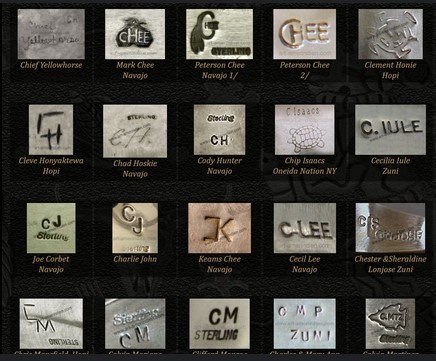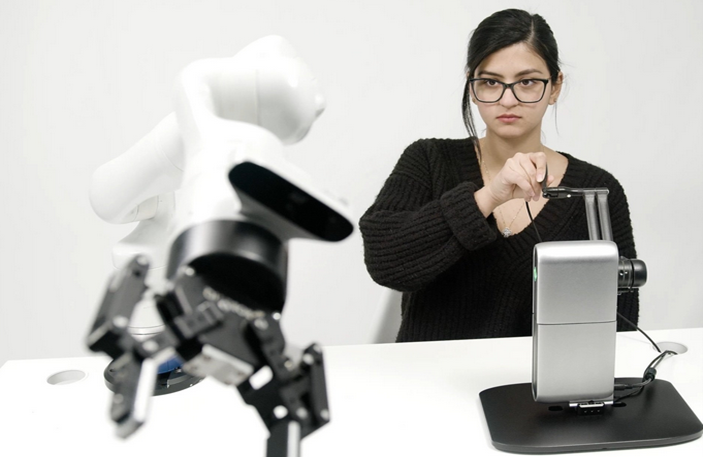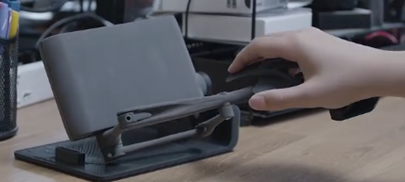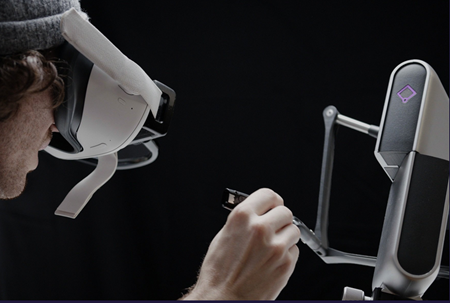The Tactile Transformation of Digital Design
(Lisa Bowers)
For some time now, I have been designing experiences for users to extend and augment their senses within the realm of digital design. As designers, our focus often lies on visual aesthetics and intuitive interactions with products, services systems or place. However, there’s a powerful sense that typically gets overlooked: touch.
Traditionally designer makers, or craft makers would argue that touch is of the uppermost importance in their work, e.g., confirming material properties, ascertaining shape, smoothing, polishing, and finishing. Richard Sennet (Craftsman, 2018) argues that “all skills, even the more abstract, begin as bodily practices” and that “technical understanding develops through the powers of imagination” [1]. Touch is so inextricably important to a craft maker that traditionally they would leave their imprint/mark on a finished piece as their own recognizable mark, aka the maker’s mark, usually an embossed tactile mark that signifies the creators’ signature.

Figure 1. 18th and 19th C. tactile makers mark
As technology continues to evolve, so does our ability to engage with digital interfaces in more tactile ways. This shift is ushering in a new era of design, one that prioritizes the sense of touch as a fundamental element of the user experience. The movement of using senses within the digital realm is a fascinating and rapidly evolving field, often referred to as often referred to as multisensory virtual reality (MSVR) or immersive technologies. It aims to create more realistic and engaging digital experiences by stimulating multiple senses, not just sight and sound.
In previous blogs I have spoken about the use of the tactile feedback – via devices such as haptic gloves, suits and deskbound devices using 3-6 Degrees of Freedom (DoF) to manoeuvre around a contained digital space. Previously, I have commented on the use of haptics to extend the augmented touch to serve people with sight impairments to ‘feel’ the digital objects contained inside the digi-verse. However, with the development of Meta-verse and Artificial intelligence (AI) the use of the senses as a meta process is advancing rapidly.
The power of synergy
HAPLY (Inc) a Canadian precision touch company are making moves towards a meta-haptic device that operates a distant robotic arm that is located in a manufacturing plant in another country. The user would operate the arm from instinctive movements and be able to pick up objects and view the movement of within the metaverse using digital twin in real time. A digital twin is the creation of a mirror image mechanical device or static objects located in the metaverse. Digital twins are being captured or created across the world to make replicas of the real world objects, devices, and machines and every digital twin device or machine acts predictably like real-world objects and machines e.g. a robot arm in the real world, will move and act the same in metaverse as a digital twin.

Figure 2. HAPLY haptic device used to control a robotic arm


Figure (3) HAPLY tactile mouse, figure (4a) inverse 3, metaverse digital twin control figure (4b) using robotic arm via haptic device,
Real-world Applications
The use of dynamic movement via haptics and digital twinning in the metaverse holds many outputs, here a just a few:
- Digital twins possess the capability to enhance production line efficiency by simulating various scenarios and pinpointing bottlenecks, while robotic arms can automate repetitive tasks, thereby augmenting both efficiency and quality.
- In the realm of healthcare, robotic arms integrated with cutting-edge surgical instruments enable the execution of intricate procedures with heightened precision. Through their simultaneous use, digital twins enhance the planning and training aspects of surgical procedures.
- Through the implementation of digital twins, warehouse layout and material flow can be optimized, while robotic arms enable automation of tasks encompassing picking, packing, and shipping.
Challenges and Future Directions:
Advancements in technology warrant careful reflection on the challenges and limitations associated with its future direction and application.
Like any technology, remote operating systems have inherent limitations. Users are required to function accurately and reliably from a remote location, a task which may pose significant physical strain over time. Moreover, latency can pose a significant impediment during prolonged periods of operation.
Ethical and physiological considerations must be given paramount importance when designing the user experience in the immersive metaverse. Large amounts of time spent within the digital realm can cause fatigue and cybersickness, and creating a sensory overload, which can create physiological issues.
The future of multisensory virtual reality holds immense potential to transform how we interact with technology and the world around us. By pushing the boundaries of sensory perception, we can manage the immersive feelings of being present in a virtual environment, and once the immersion in that new world grow, the brain and the body will react in the same way as it would in the real world. Once the presence and immersion are fully established, the benefits of moving to being present in a virtual world hold countless benefits. From working at a distance, education, and training at a distance or connecting with loved ones at a distance, gaining immersive sensory interactions will elevate how we connect on a human-to-human basis.
The Future of Tactile Design
As technology advances, we can expect to see even more innovative ways to incorporate touch into digital metaverse for design praxis. From haptic feedback devices to immersive virtual reality experiences, the possibilities are endless. By embracing the power of touch, designers can create truly transformative user experiences that resonate on a deeper level.
In Conclusion
The sense of touch is a powerful sensory perception connections that can elevate digital design to new heights. By understanding the principles of tactile design and applying them to our work, we can create more engaging, accessible, and emotionally resonant user experiences. As designers, let us embrace the future of touch and shape the next generation of digital interactions.

Leave a Reply